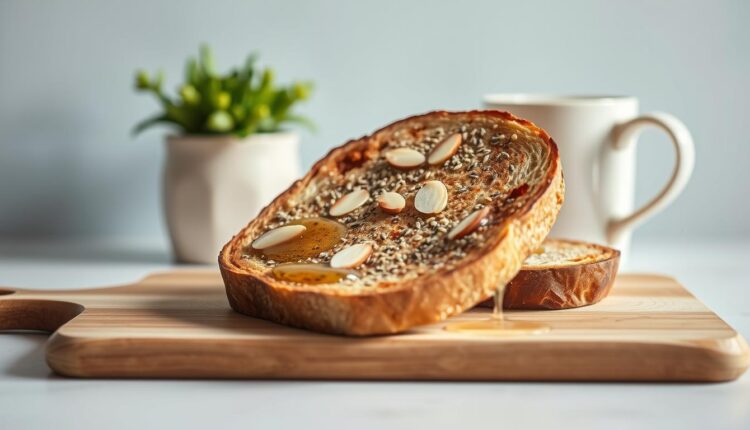Low Sugar Breakfast High Fiber For Digestive Health
Boost your digestive health with our low sugar breakfast high fiber recipes. Easy, delicious, and nutritious meal ideas to kickstart your day.
Three years ago, I ruined a perfectly good batch of oatmeal by drowning it in maple syrup. The sugar crash hit me like a Monday morning alarm clock. That’s when I discovered something surprising: a balanced morning meal doesn’t need sweetness to feel satisfying.
Starting your day with the right ingredients does more than curb cravings. Nutrient-rich choices nourish your gut’s microbiome – those hardworking little organisms influencing everything from energy levels to mood. Research shows meals rich in whole grains and plants help stabilize glucose levels while supporting digestion naturally.
- Morning meals set your metabolic rhythm
- Smart ingredient swaps boost gut health
- Simple recipes make consistency effortless
Later, I’ll share my favorite toasted seed sprinkle (it’s rescued countless rushed mornings) and a genius way to repurpose last night’s roasted veggies. Because when you focus on what fuels you, every sunrise becomes an opportunity to thrive.
Fiber and Its Digestive Health Benefits
I once burned three pans of roasted almonds trying to make “healthy” granola. Through that smoky disaster, I learned fiber does more than keep things moving – it’s your gut’s best friend. Let’s break down why this nutrient deserves a front-row seat at your breakfast table.
Your Gut’s Cleaning Crew
Dietary fiber acts like nature’s broom. Found in plants, it resists digestion but feeds your gut bacteria. One cup of spinach delivers 4 grams – that’s 16% of your daily needs. These plant fibers help:
- Balance blood sugar levels
- Support healthy cholesterol
- Keep elimination regular
The Dynamic Duo
Not all fibers work the same. Soluble types dissolve in water, forming a gel that slows digestion. Oats (4 grams per ½ cup) and broccoli shine here. Insoluble fibers add bulk – think wheat bran and brown rice. Both types team up to:
| Type | Best Sources | Key Benefit |
|---|---|---|
| Soluble | Oats, apples, beans | Feeds good gut bacteria |
| Insoluble | Whole grains, celery | Prevents constipation |
Registered dietitians suggest boosting intake gradually. Add a tablespoon of chia seeds to smoothies or swap white bread for whole grain. Your digestive system will thank you by lunchtime.
The Importance of a Low Sugar Breakfast
Last winter, I nearly turned my morning smoothie into syrup by overloading it with honey. The brain fog that followed taught me what research confirms: starting your day with too much sweetness can sabotage your digestive system before noon even hits.
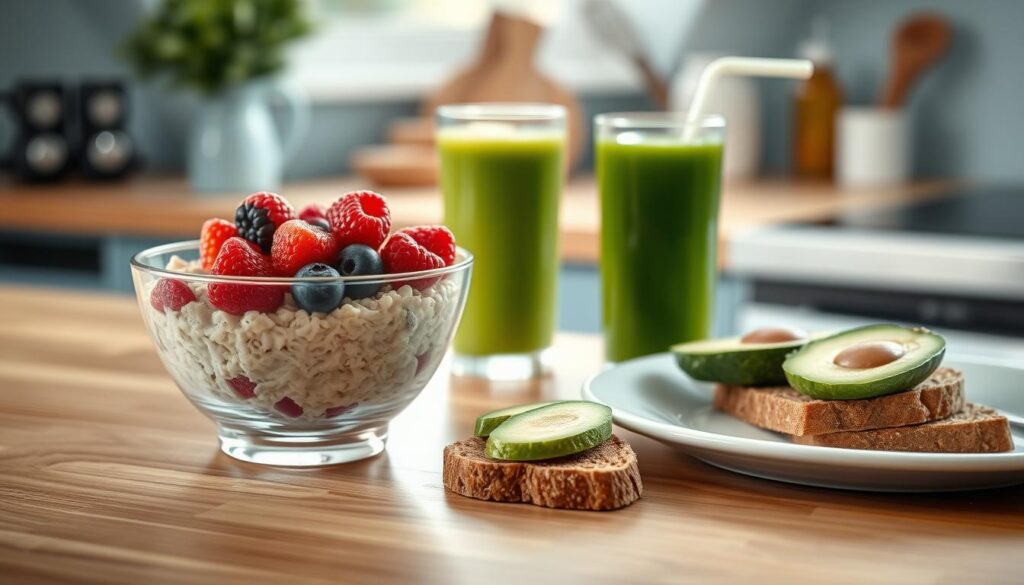
Impact of Excess Sugar on Digestion
Your gut bacteria react to refined sugars like toddlers at a candy store – initial excitement followed by chaos. Studies show meals with over 25 grams of added sugar:
- Disrupt healthy gut flora balance within 4 hours
- Suppress leptin (the “I’m full” hormone) by up to 30%
- Trigger blood sugar spikes that leave you ravenous by mid-morning
Benefits of Reducing Sugar in the Morning
Swapping sweetened cereals for savory options like make-ahead breakfasts with beans or roasted veggies creates a ripple effect. Your body gains:
| Morning Change | Afternoon Result | Long-Term Benefit |
|---|---|---|
| Black coffee instead of flavored creamer | Stable energy until lunch | Improved insulin sensitivity |
| Whole grain toast over pastries | Better focus | Healthier gut microbiome |
Start small: mix half sugary yogurt with plain Greek yogurt for a week. Gradually increase fiber-rich add-ins like chia seeds or mashed black beans. Your digestive rhythm will sync up faster than you’d think.
Why Choose a High Fiber Breakfast
I nearly threw my meal prep calendar out the window last month after burning yet another batch of “quick” breakfast muffins. That frustration taught me what nutrition science confirms: morning meals built on plants and grains deliver lasting fuel better than any rushed pastry ever could.
Enhanced Satiety and Energy
Your morning bowl of oats (4 grams fiber per ½ cup) acts like a time-release energy capsule. Soluble fibers form a gel that slows digestion, while insoluble types in whole grain toast add bulk. Together, they:
- Delay hunger signals for 3-4 hours
- Prevent mid-morning energy crashes
- Stabilize glucose absorption
One client swapped sugary cereal for quinoa bowls with roasted veggies. She reported feeling “alert until lunch” within three days.
Improved Gut Health and Regularity
Your microbiome thrives on diverse fibers. Think of each spoonful of chia seeds (10 grams fiber per ounce) as fertilizer for beneficial bacteria. Nutrition experts note consistent benefits:
| Daily Habit | Digestive Impact |
|---|---|
| 1 cup raspberries | 8 grams fiber supports regularity |
| Whole grain wraps | Insoluble fiber adds bulk |
Start with simple recipe swaps like mixing nut butter into oatmeal instead of syrup. Your gut will reward you with smoother digestion – and fewer urgent bathroom dashes.
Low Sugar Breakfast High Fiber Recipe Inspirations
My kitchen victory came when I transformed leftover roasted squash into a savory breakfast hash. That’s when I realized morning meals could be both nourishing and exciting. These simple creations prove flavor doesn’t require sweetness – just smart combinations.
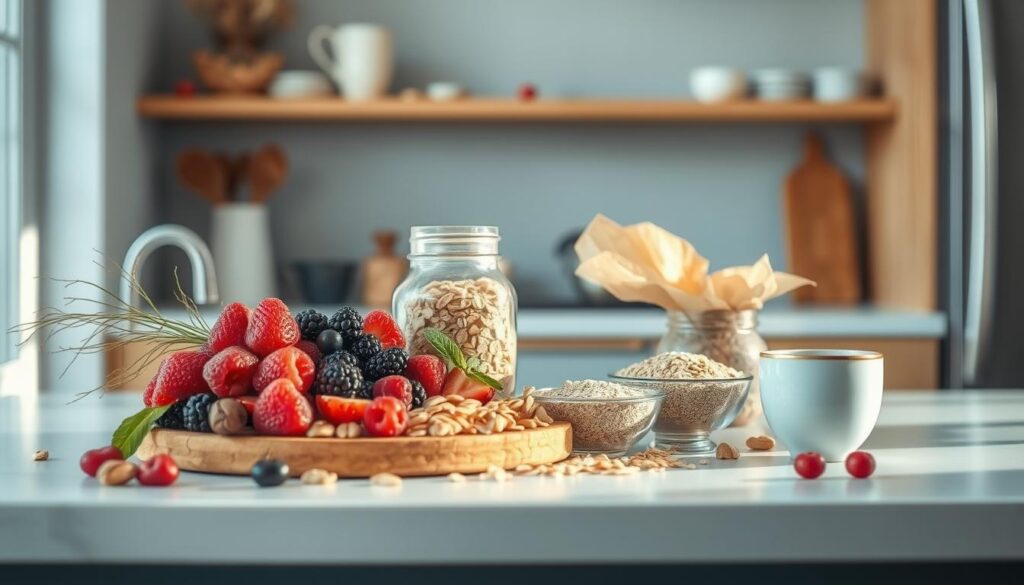
- Zesty Avocado Toast: Mash ¼ avocado on whole grain bread, top with radish slices and everything bagel seasoning
- Savory Oatmeal Bowl: Cook oats in vegetable broth, stir in wilted spinach and a soft-boiled egg
- Berry Chia Parfait: Layer unsweetened coconut yogurt with chia pudding and fresh raspberries
One client told me, “The turmeric-spiced chickpea scramble became my go-to – it keeps me full through back-to-back meetings.” Batch-cook components like roasted sweet potatoes or marinated beans for grab-and-go assembly.
Three time-saving tricks from my recipe testing fails:
- Freeze portioned smoothie packs with kale, banana, and flaxseed
- Roast a week’s veggies while dinner cooks
- Store nut butter in squeeze bottles for drizzle-ready toppings
These breakfast ideas adapt to any palate. Swap ingredients based on what’s in season or your pantry. Your morning plate should energize – not exhaust – you.
Fiber in Breakfast Staples: Oats, Chia Seeds, and Whole Grains
Last summer, I discovered chia pudding could double as wallpaper paste if left too thick. That gloopy disaster taught me kitchen magic happens with precise ratios – and the right staples. Let’s explore three pantry heroes that transform morning meals into gut-loving rituals.
Creative Oatmeal Variations
Rolled oats (4g fiber per ½ cup) become blank canvases with smart add-ins. Try these combos:
- Savory Mediterranean: Stir in sun-dried tomatoes, Kalamata olives, and crumbled feta
- Spiced Apple: Fold in grated apple, cinnamon, and toasted walnuts
- Green Goddess: Mix wilted kale, fried egg, and everything bagel seasoning
Batch-cook steel-cut oats in your slow cooker overnight. Portion into jars for grab-and-go mornings.
Chia Pudding and Whole Grain Options
Chia seeds (10g fiber per ounce) thicken beautifully when soaked overnight. Combine ¼ cup seeds with 1 cup almond milk. Layer with:
| Base | Toppings | Fiber Boost |
|---|---|---|
| Unsweetened cocoa | Sliced banana | 3g per medium fruit |
| Vanilla extract | Toasted coconut | 4g per ¼ cup |
Whole grains like quinoa or barley work in both sweet and savory bowls. Toss cooked grains with roasted veggies or fresh berries. Your gut gets diversity – your taste buds get excitement.
Incorporating Fruits and Vegetables for Enhanced Fiber
Last spring, I accidentally turned a breakfast smoothie into a sugar bomb by adding too many dates. That sticky mess taught me nature’s candy—whole fruits and veggies—delivers sweetness and substance without the crash. Fresh produce brings more than color to your plate—it transforms morning meals into gut-nourishing rituals.
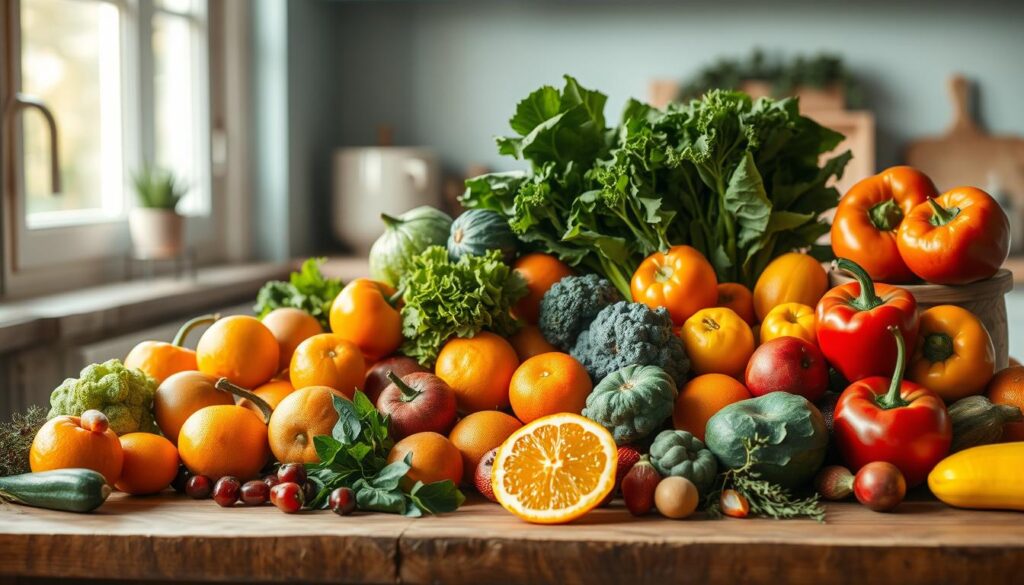
Smart Fruit Selection
Not all fruits pack equal fiber punches. Raspberries lead the pack with 8 grams per cup. Pair them with chia seeds (1 tablespoon = 5 grams) in overnight oats for texture and staying power. Apples with skin offer 4.5 grams—slice them thin for nut butter sandwiches.
“Whole fruits provide water-soluble fibers that feed beneficial gut bacteria,” notes nutritionist Dr. Emily Torres. “They’re nature’s multivitamins.”
Veggie-Powered Mornings
Spinach (4 grams per cooked cup) blends seamlessly into scrambled eggs. Shredded carrots or zucchini fold into whole grain pancake batter. Try these combos:
| Vegetable | Prep Idea | Fiber Boost |
|---|---|---|
| Bell peppers | Diced in breakfast tacos | 2g per ½ cup |
| Kale | Massaged into grain bowls | 2.5g per cup |
Roast a sheet pan of cubed sweet potatoes and Brussels sprouts on Sundays. Toss them into wraps with hummus throughout the week. Your plate becomes a rainbow—your digestion gets rhythm.
Pro tip: Freeze overripe bananas in chunks. They’ll sweeten smoothies naturally while adding 3 grams of fiber each. No sugar spikes—just sustained energy to tackle your day.
Protein and Fiber Synergy in Breakfast
Last Tuesday, I turned leftover grilled chicken into a breakfast hash that kept me full until noon. That’s when I realized the magic happens when protein meets fiber. This combo doesn’t just fill your plate – it fuels your body like a slow-burning campfire.
Egg-Based Dishes and Plant Proteins
Scrambled eggs become power players when paired with veggies. Try sautéing spinach (4g fiber per cooked cup) with garlic, then folding in whisked eggs. Add a sprinkle of black beans (7g fiber per ½ cup) for texture. Research shows meals with 20g protein and 5g fiber:
- Increase satiety hormones by 30%
- Delay hunger signals for 4+ hours
- Support gut lining repair
Combining Protein with Fiber-Rich Foods
Think beyond omelets. Stir cooked lentils into oatmeal or layer hummus on whole grain toast. My favorite hack? Keep pre-cooked beans in the fridge for quick additions. Try these combos:
| Protein Source | Fiber Partner | Total Fiber |
|---|---|---|
| 2 eggs | ½ avocado + ¼ cup black beans | 9g |
| Greek yogurt | Chia seeds + raspberries | 11g |
Time crunch? Microwave an egg in a mug, then top with salsa (2g fiber per ¼ cup). Your gut gets nourishment – your schedule gets grace.
Delicious Toast Toppings for a Fiber Boost
Last month, I turned my toaster into a smoke machine trying to “caramelize” almond butter. That charred mess taught me toast becomes extraordinary when you treat it as a blank canvas – not a cooking challenge. Your morning slice can deliver 8+ grams of fiber with smart layering.
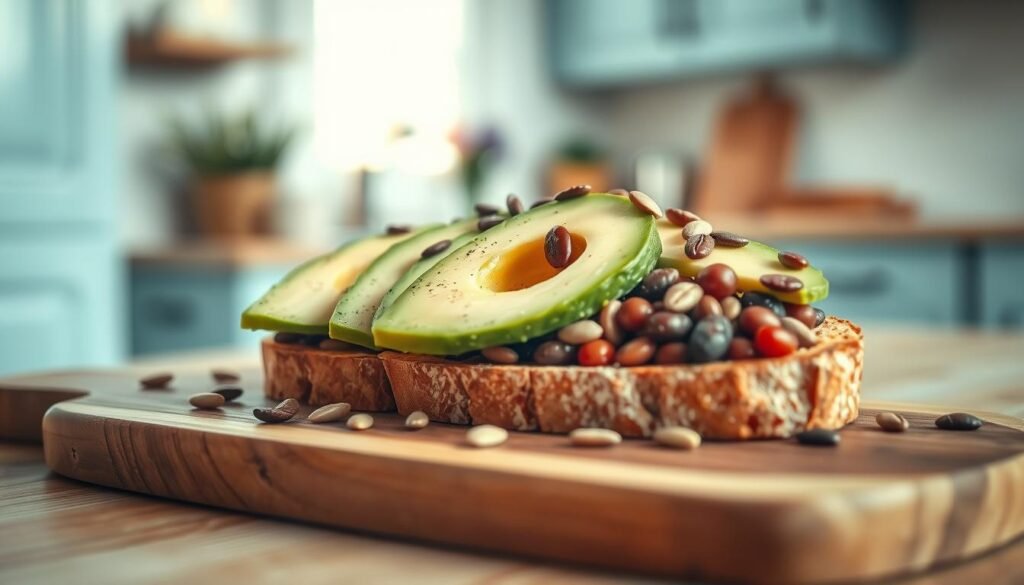
Beyond Basic Smashed Avocado
Ripe avocado (3g fiber per ½ fruit) makes the perfect creamy base. Try these twists:
- Mediterranean Mash: Layer hummus, sliced cucumber, and pumpkin seeds on rye bread (5g fiber)
- Spiced Black Bean: Top mashed avocado with seasoned beans and sunflower seeds (7g combined fiber)
- Pickled Radish Crunch: Add quick-pickled veggies and hemp hearts to sourdough (6g fiber)
Powerhouse Bean & Seed Combos
Crushed lentils or white beans add protein and texture. Pair them with:
| Base | Topping | Fiber Per Slice |
|---|---|---|
| Mashed cannellini beans | Everything bagel seasoning | 5g |
| Refried pinto beans | Toasted sesame seeds | 6g |
Choose breads with “whole grain” as the first ingredient. My favorite sprouted wheat loaf packs 4g fiber per slice. Keep pre-toasted seeds in jars for instant crunch. Your morning ritual becomes both nourishing and adventurous – no smoke detectors required.
Smoothies and Smoothie Bowls Packed with Fiber
I finally cracked the code to creamy morning blends after a decade of gritty green experiments. The secret? Balancing frozen fruits with smart thickeners creates spoonable textures that keep you satisfied until lunch. These vibrant bowls and drinks turn produce into portable fuel – no fancy equipment required.
Blender Magic in Minutes
My go-to base combines ½ cup frozen blueberries (4g fiber) with ¼ avocado (3g) and unsweetened almond milk. Add these power-ups:
- 1 tbsp ground flaxseed (2g fiber)
- ½ cup steamed then frozen cauliflower (2g)
- Pinch of cinnamon for natural sweetness
Nutritionists recommend 25-35g daily fiber. One serving of this blend delivers 11g – nearly half your needs before 9 AM.
Crunch Factor Matters
Texture transforms sipping into an experience. Try these combos:
| Base | Toppings | Total Fiber |
|---|---|---|
| Greek yogurt smoothie | Toasted coconut + chia seeds | 7g per cup |
| Spinach-banana blend | Crushed walnuts + cacao nibs | 9g per bowl |
Prep freezer bags with measured ingredients on Sundays. Morning you will bless past you when grabbing a pack and blitzing with liquid. Rotate seasonal fruits to keep taste buds guessing – frozen zucchini works surprisingly well in peach blends.
Breakfast Salads and Wraps for a Nutrient Boost
I used to laugh at the idea of greens before noon – until a farmer’s market haul forced me to get creative. Turns out, tossing veggies with protein first thing sparks energy that cereal just can’t match. Morning salads aren’t rabbit food – they’re crunchy fuel stations packed with gut-friendly fiber.
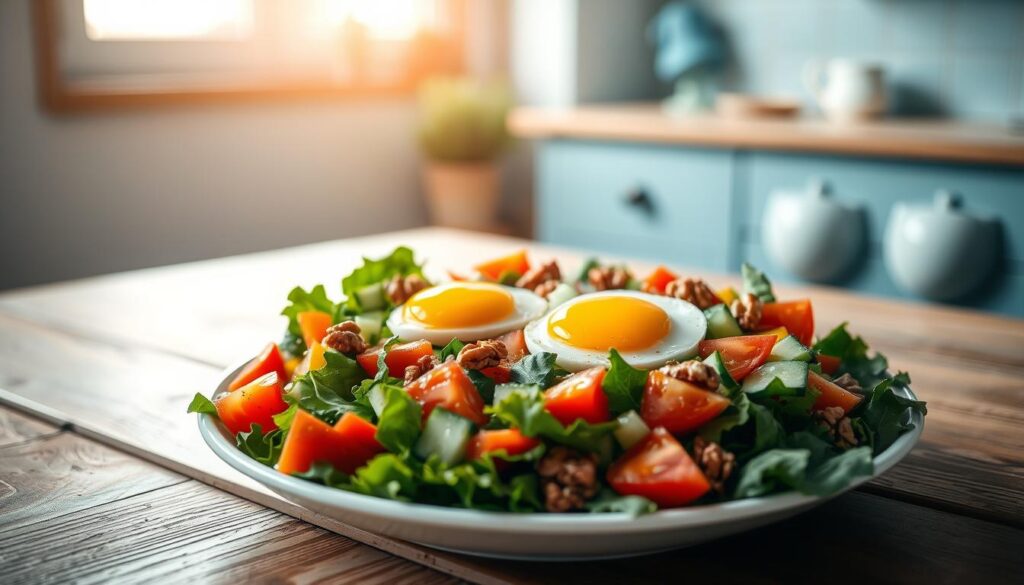
Fresh Salad Combinations
Start with a base of massaged kale or spinach (4g fiber per cup). Add texture with roasted chickpeas (6g fiber per ½ cup) or black beans. Top with:
- Shredded carrots and radishes for crunch
- Hard-boiled eggs or smoked salmon for protein
- Toasted sunflower seeds for healthy fats
My current favorite combines arugula, white beans, and pickled onions. Drizzle with lemon-tahini dressing – it’s ready faster than toast pops up.
| Ingredient | Fiber Boost | Prep Tip |
|---|---|---|
| Mixed greens | 2-4g per cup | Pre-wash & spin dry |
| Canned beans | 7g per ½ cup | Rinse for less sodium |
| Whole grain wrap | 5g each | Warm briefly to prevent cracking |
Wrap it all in a sprouted grain tortilla for portable mornings. One client told me, “The chickpea-avocado wrap keeps me full through morning meetings – no 10 AM snack cravings.”
Pro tip: Keep pre-chopped veggies in glass containers. Layer ingredients jar-style – greens at the bottom, toppings above. Your morning becomes assembly, not cooking.
Innovative Uses of Almond and Coconut Flour in Breakfasts
I once served hockey-puck pancakes to my niece, unaware that all-purpose flour was the culprit. Switching to almond flour transformed my batter – and my reputation. These grain-free options aren’t just for gluten-free diets. They’re secret weapons for adding texture and nutrients to morning meals.
Almond flour packs 8 grams of fiber per cup – triple regular flour’s content. Coconut flour brings 10 grams, plus natural sweetness. Try these swaps:
- Blueberry Muffins: Replace 1:1 with almond flour, add mashed banana for moisture
- Pancakes: Mix coconut flour with eggs and almond milk for fluffy stacks
- Waffles: Combine both flours with baking soda – crisp outside, tender inside
“These flours offer prebiotic fibers that feed gut bacteria differently than grains,” explains chef-nutritionist Marco Perez. “They’re game-changers for sensitive digestive systems.”
| Flour Type | Fiber Per Cup | Best For | Texture Tip |
|---|---|---|---|
| Almond | 8g | Dense baked goods | Add 1 extra egg |
| Coconut | 10g | Light batters | Use 25% less liquid |
Stir nut butter into coconut flour batter for richness. Top almond flour muffins with fresh figs – their seeds add crunch and extra fiber. Batch-bake and freeze for grab-and-go mornings.
My favorite hack? Use leftover pulp from homemade almond milk. Dry it overnight, then blend into flour. Waste-free and wallet-friendly – just like your gut deserves.
Nutritional Insights from Registered Dietitians
Last week, I learned the hard way that adding too much flaxseed to pancakes can turn them into bricks. Dietitian Laura Iu chuckled when I shared this story, then offered wisdom I wish I’d known years ago: “Think of fiber like a new workout routine – start slow and build gradually.”

Expert Tips on Fiber Intake
Most adults need 25-38 grams of plant roughage daily, but jumping straight to kale smoothies can backfire. Megan Hilbert, MS, RDN, suggests this approach:
- Week 1: Add 1 tbsp chia seeds to oatmeal
- Week 2: Swap white rice for quinoa in breakfast bowls
- Week 3: Fold roasted veggies into scrambled eggs
Pairing matters more than perfection. Laura explains: “Fiber works best with partners. Try nut butter on apple slices or hummus with carrot sticks. The fats and proteins help your body process the nutrients.”
| Morning Habit | Fiber Boost | Partner Food |
|---|---|---|
| Berry smoothie | 5g | Greek yogurt |
| Avocado toast | 7g | Soft-boiled egg |
Struggling with bloating? Hilbert recommends drinking water with high-fiber meals. “It’s like giving your gut a helping hand,” she says. “Hydration helps dietary bulk move smoothly through your system.”
These strategies transformed my brick-like pancakes into fluffy almond flour versions with raspberries. Your kitchen experiments can thrive too – one gradual tweak at a time.
Meal Prep Strategies for High-Fiber Breakfasts
Last Thursday, I discovered forgotten chia pudding jars behind the milk carton – three days old but perfectly set. That happy accident taught me kitchen prep works best when you let time do the heavy lifting. With smart planning, you can turn Sunday effort into weekday victories.
No-Fuss Fuel Stations
Overnight chia pudding becomes creamy magic without morning work. Combine:
- ¼ cup chia seeds (10g fiber)
- 1 cup unsweetened almond milk
- 1 tsp vanilla extract
Let it rest in mason jars overnight. Morning add-ons:
| Topping | Protein Boost | Fiber Bonus |
|---|---|---|
| Toasted walnuts | 4g per ¼ cup | 2g |
| Mashed black beans | 7g per ½ cup | 6g |
Freezer-Friendly Morning Heroes
Baked egg bites travel better than omelets. Whisk together:
- 6 eggs
- ½ cup cooked quinoa
- ¼ cup diced roasted peppers
Bake in muffin tins at 350°F for 20 minutes. Pair with pre-toasted whole grain bread (5g fiber per slice) for instant sandwiches.
My Sunday reset routine includes:
- Roasting two sheet pans of veggies
- Pre-measuring chia pudding bases
- Storing nut butters in squeeze bottles
One client texted: “Grabbing bean-stuffed egg bites changed my commute – no more drive-thru temptation.” Your future self will high-five you through the coffee steam.
Fiber Facts and Research: What Science Says

In my early meal prep days, I accidentally created a lentil-oat bake that kept me fueled through a cross-country flight. That kitchen experiment revealed what researchers confirm: plant roughage does more than regulate digestion—it rewires how our bodies use energy.
Your Gut’s Peacekeeper
When gut microbes break down fibers like beta-glucan (found in oats), they produce short-chain fatty acids. A Nutrients journal study shows these compounds:
- Reduce intestinal inflammation by 40% in animal models
- Strengthen the gut lining’s protective mucus layer
- Signal immune cells to lower systemic inflammation
Just ½ cup of blackberries delivers 4 grams fiber—enough to kickstart this process. Pair them with chia seeds (5 grams per tablespoon) for a microbiome power meal.
The Energy Stabilizer Effect
Steel-cut oats (5 grams fiber per ¼ cup) release glucose slower than sugary cereals. This steady drip:
| Time After Eating | Blood Sugar Impact |
|---|---|
| 1 hour | +15 mg/dL |
| 3 hours | +5 mg/dL |
| 5 hours | -2 mg/dL |
Compare that to a muffin’s +45 mg/dL spike and crash. Harvard researchers found consistent fiber intake cuts afternoon fatigue by 31% in office workers.
“Think of fiber as your body’s pace car—it keeps energy output smooth and prevents metabolic whiplash.”
Simple swaps make a difference. Try roasted chickpeas instead of croutons on breakfast salads. Your cells get steady fuel—your taste buds get crunch.
Balancing Soluble and Insoluble Fiber in Your Diet
Last month, I found a forgotten mason jar of overnight oats layered with raspberries and flaxseed. This happy accident revealed nature’s perfect fiber duo – soft soluble strands hugging crunchy insoluble bits. Like yin and yang for your gut.
The Dynamic Digestion Duo
Soluble fiber dissolves into a gel that feeds good bacteria. Think oats, apples, and lentils. Insoluble types add bulk – try wheat bran or celery. Together, they:
- Keep digestion moving smoothly
- Balance blood sugar levels
- Support long-lasting energy
| Type | Top Sources | Per Cup Fiber |
|---|---|---|
| Soluble | Blackberries | 8g |
| Insoluble | Chopped kale | 5g |
| Combo | Edamame | 9g |
Spinach offers both types – 4 grams per cooked cup. Toss it into scrambled eggs or smoothies. My favorite hack? Mix chia seeds (soluble) with roasted pumpkin seeds (insoluble) for a gut-friendly sprinkle.
“Pairing fiber types creates digestive harmony. It’s like having both a shovel and broom for your intestines.”
Start with simple swaps: add flaxmeal to yogurt or choose whole grain crackers. Your body thrives on variety – give it both fiber flavors.
Last week, I nearly tossed a batch of roasted veggies thinking they were too plain—until I realized their simplicity was the secret. Nourishing meals don’t need complexity. Choosing ingredients that work with your body sets the tone for your entire day.
Those avocado toast variations and chia bowls we explored? They’re more than recipes. They’re tools to help your gut thrive. Science confirms what dietitians preach: steady energy starts with plants, grains, and mindful swaps.
Remember the roasted chickpea scramble? Or freezing smoothie packs during Sunday prep? Each idea serves one purpose: making consistency effortless. Even switching your bread or adding hemp hearts counts.
Your digestive system thrives on small, frequent kindnesses. One client texted me after trying spiced black bean toast: “I finally understand what ‘feeling fueled’ means.” That’s the power of intentional choices.
Ready to experiment? Share your kitchen wins (or hilarious fails) with our community. Because every tweak—no matter how tiny—adds up to a healthier rhythm. Your future self will savor the results.
Savory Lentil Breakfast Wraps with Avocado Smash
A protein-packed, plant-based breakfast wrap featuring seasoned lentils, creamy avocado smash, and crisp vegetables, all wrapped in a warm tortilla for a satisfying start to your day.
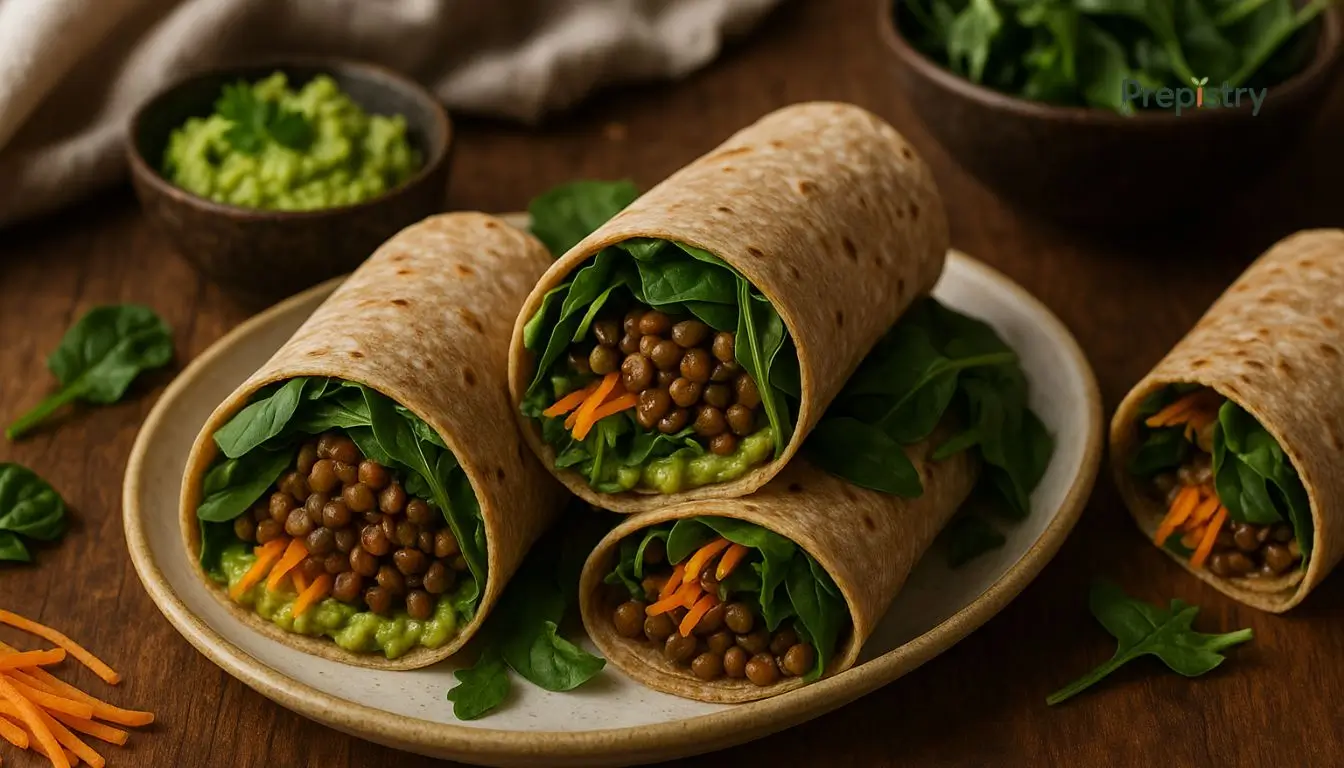
Nutrition Information
Equipment Needed
- Medium saucepan
- Mixing bowls
- Fork or potato masher
- Knife
- Cutting board
- Skillet or frying pan
- Spatula
Ingredients
-
1 cup dry green or brown lentils
-
2 cups water
-
1 teaspoon ground cumin
-
1/2 teaspoon smoked paprika
-
Salt and pepper to taste
-
2 ripe avocados
-
1 tablespoon lemon juice
-
1/4 teaspoon garlic powder
-
4 large whole wheat tortillas
-
1 cup shredded lettuce
-
1/2 cup diced tomatoes
-
1/4 cup thinly sliced red onions
-
1/4 cup chopped fresh cilantro
Instructions
Recipe Video
Quick & Healthy Recipe: Lentil Avocado Wrap
Discover a fast and nutritious lentil avocado wrap recipe, perfect for busy individuals. Enhance your meal prep with soothing ASMR sounds and enjoy fresh, wholesome ingredients.

